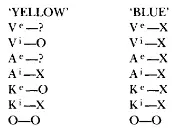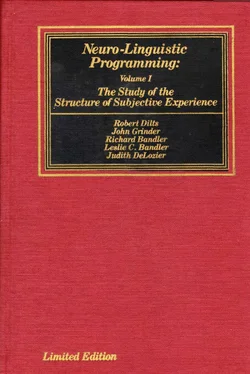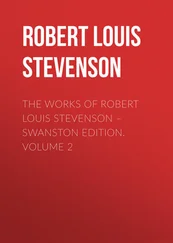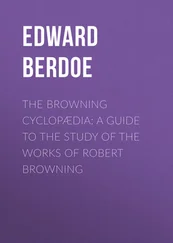The reason that we have five senses is because they are all resources and each one can pick up information that isn't available to our other senses. We can hear things that we can't see or feel; we can see things that we can't feel, hear or smell; we can smell things that we can't hear or see; we can feel things that we can't see, hear or smell; and so forth … There are many situations that you can't see your way out of, a lot of situations you won't be able to talk, listen or shout your way out of, other situations you can't feel your way out of and so on.
If you want to be able to deal effectively with a situation you need access to all of your representational systems … Losing access to sensory resources is probably the primary block to problem solving … What I want to do is help Jan get access to those resources in her problem state by anchoring a state in which she naturalistically has access to the representational systems that she's missing when she 'yellows' … It's unfortunate, but what generally happens when people come up against a problem or a frustrating or negative situation is that the negative feelings or their internal dialogue or whatever begin to anchor up other negative situations or 4–tuples associated with the bad experience, rather than going right for the resources. They begin to spiral, or loop, in the bad experience, and that keeps them from getting to their resources … [To Jan] So, what I'd like you to do now, Jan, is to think of a time when you had your full potential and resources as a person. A time when you had full contact with the world around you as well as access to internal creativity and confidence. A time when you were able to handle anything that came up.
S: (Eyes down and right then up, straight left and up and right. Straightens posture from slumping position to erect, with shoulders back. Breaths smoothly and easily from whole chest. Smiles a broad smile. Color comes to her face.) Uh-huh … (Tonality strong and resonant.)
A: (Squeezes left shoulder) Now that's what I call 'blue'… (laughter) … In this state, Jan, that we're going to call 'blue', are you able to see clearly what is going on around you?
S: (Smiles, eyes defocus, nods) Oh yes, very clearly.
A: (Squeezes S's left shoulder) I thought so. How about inside your head, can you make clear pictures in there?
S: (Eyes up and right). Yes … But I don't do it all of the time … only when I need to think about something or piece something together.
A: (Squeezes S's left shoulder). OK, good … How well can you hear what's going on outside of you when you're 'blue'?
S: (Eyes level, shift straight across back and forth.) Oh, fine (nods her head) … I'm really aware of what people are saying to me.
A: (Squeezes S's left shoulder) … Now many of you may have noticed that I'm using the same anchor that I used for the other resource, that wasn't effective when we collapsed the anchors before. What I'm doing is what we call "stacking" anchors in NLP. That is, I'm making this anchor an anchor for more than one resource. I'm really building up the resources on this side by collapsing two positive experiences together … You can, of course, stack as many positive anchors as you need in one place … You can also anchor the same experiences in as many places or through as many systems as you need … In fact, Jan, I'd like you to help me out with this as we go on. And what I would like you to do, as you access the information I'm requesting of you, is to squeeze your left hand into a fist only as tight as you are able to access the state and the information fully and completely. So, the more you are squeezing your hand, the more you are accessing the resources. Okay?
S: Squeeze my hand like this? (Squeezes left hand into a fist.)
A: Yes … that'll be fine. But remember, only as intensely as you access the experience … Now I just have a couple more questions … Do you have any internal dialogue when you're 'bluing'?
S: (Eyes down and left) … Umm, Yes … but it's real different than when I'm 'yellow' … It comments more on what's going on around me when I'm 'blue', rather than trying to tell me what to do all the time like it does when I'm yellow … And it's going a lot less of the time. (As S talks she squeezes her fist tighter.)
A: (Squeezes S's shoulder) … Very good … How about external body awareness. Are you aware of how your body feels?
S: (Eyes down and right. Breathing shifts to abdomen.) Yes … I'm generally very relaxed … not tense … and my body feels very centered. (Squeezes her fist.)
A: (Squeezes S's left shoulder.) … All right. Are you aware of internal feelings when you 'blue'?
S: (Eyes remaining down and right, smiles.) Oh yes … I feel really confident and excited. (Squeezes fist.)
A: (Squeezes S's left shoulder.) Where in your body do you feel this?
S: Right in here. (Indicates midline area.)
A: (Squeezes S's shoulder.) Okay, do you smell anything, or taste anything?
S: (Eyes straight right, down left then up.) … Ahh … no, I don't think so.
A: (Squeezes S's left shoulder.) Okay … how about internally. Are you remembering any smells or tastes?
S: Not that I am aware of… (Squeezes fist.)
A: (Squeezes S's left shoulder.) … Fine. (To audience) As you've noticed, this 'blue' is a very different state than the 'yellow'.
(Agreement from audience).
A: Let's look at some of the differences. (Writes on blackboard.)

A: 'Blue' has a lot of resources that tend to get screened out in 'yellow' … (S laughs) … What?
S: I've been trying out my anchor (Squeezes fist)… I like this one.
A: (Laughs.) Well good … Now we can give you a chance to use it … I'd like to offer you a context in which to make use of that anchor. You have a particular situation or state that we have called 'yellow' that you'd like to have more choices about. Your present experience of 'yellow' is a very valuable resource for you because it lets you know that you need to 'blue'. And what I'd like you to do right now is to go back to the last time you experienced 'yellow' and put yourself back into that situation until you see, hear and feel what you were experiencing then. (Squeezes right shoulder.) I want you to imagine how it would have been different if you had been able to bring some 'blue' into that circumstance. (Squeezes left shoulder.) And as you do this I'd like you to squeeze your fist together as much as you need to be able to make whatever changes you need to.
S: (Squeezes her fist. Adjusts posture to sit upright. Takes a deep breath. Eyes shift from down left to up left to down right and then up right. Skin flushes slightly. Smiles and begins to nod her head up and down) … Oh yes … It's a lot clearer now … (Eyes return to straight ahead position but remain defocused)… . (S's eyes become damp) … That's very powerful.
A: Satisfied?
S: Oh yes … (Nods) … I keep flashing (eyes move up & left) on more and more things that I can do.
A: Good. I'm satisfied that she hit all representational systems. I was watching for her cues. How about everybody else? Does your sensory experience check out? (Agreement from the audience.)
A: Every good engineer, of course, will make a set of blueprints before he initiates a project. What we have done here by reprogramming Jan's experience of yellow is a form, a simple form, of behavioral engineering. So what I'd like to do now is have Jan make a detailed blueprint for herself of how her experience will change the next time she encounters yellow. How her specific actions will be different. This is called "future pacing" in NLP … Now if you have lots of time and you aren't doing covert work, you can go over specifics with your client. This can be done through discussion, role playing, guided fantasy … any number of ways are available to you. I'm just going to have Jan fill in the details on her own through her own imagination, using my sensory experience of her nonverbal behavior to make sure, at the formal level, that all of the pieces are there. Remember that, because your internal representations share the same neurology as those that come from external sources, this kind of blueprinting can be as profound as the real thing … Jan, can you think of a time in the near future when you might come up against 'yellow' again?
Читать дальше












